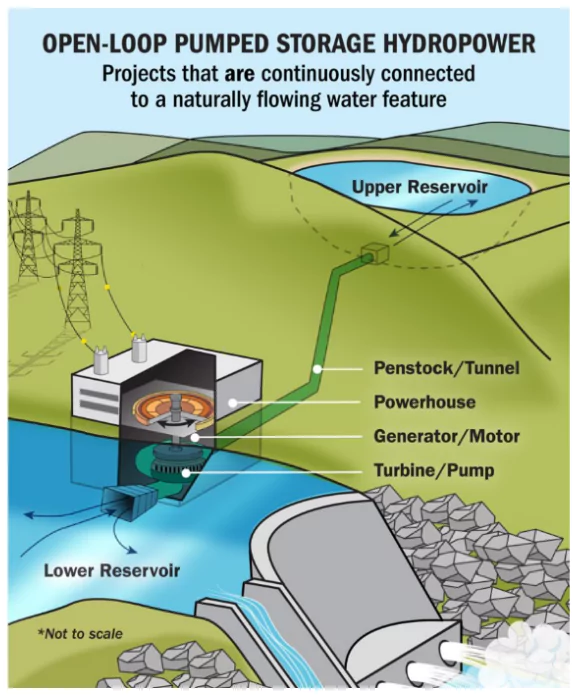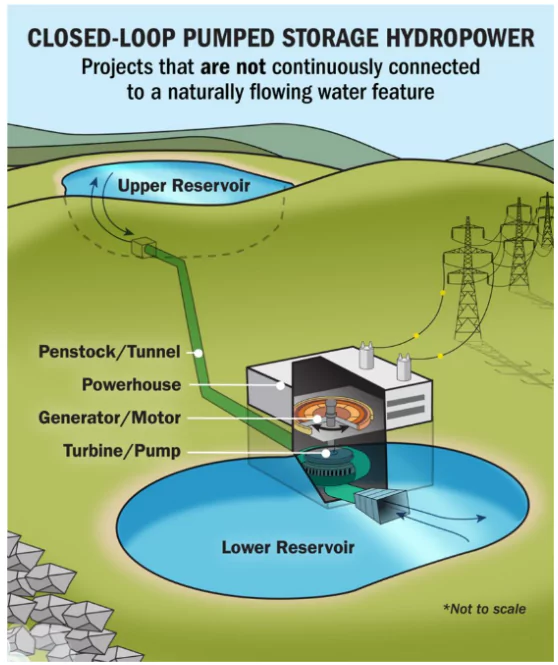The Budget 2024-25 promised that “a policy for promoting pumped storage projects will be brought out.
- It aims for electricity storage and facilitating smooth integration of the growing share of renewable energy with its variable and intermittent nature.”
About Pumped Storage Hydropower (PSH)
According to the International Hydropower Association (IHA), PSH is the largest form of renewable energy storage, with an installed capacity of nearly 200 gigawatts.

- Refers: PSH iRansomware Attacks a type of hydroelectric energy storage.
- Types: Pumped storage is of two types: on river and off river.
- On-river is like any hydroelectric project supplied by a river. Existing hydro projects could become pumped storage.
- Off-river projects are those that have two reservoirs at two different levels to which the water is pumped up or falls down to under gravity in a closed loop.
- Abandoned mines can be converted to such reservoirs.
- When there is surplus power, water is pumped up from lower to upper reservoir and when power is needed the water can fall down under gravity to turn the turbines and generate power.
- Working: It is a configuration of two water reservoirs at different elevations that can generate power as water moves down from one to the other (discharge), passing through a turbine. The system also requires power as it pumps water back into the upper reservoir (recharge).
- PSH acts similarly to a giant battery, because it can store power and then release it when needed.
 Need:
Need:
- Energy Target: India has planned to create an ambitious 500 GW of non-fossil power by 2030. India has 3.3 GW of pumped storage. Main ones are Nagarjunasagar, Kadana, Kadamparai, Panchet and Bhira.
- China Factor: China leads the world with 44 GW of pumped storage supporting 1,300 GW of wind and solar. India would therefore need to ramp up its pumped storage capacity by several times if it wants to meet its renewable power generation targets.
- India’s Notable Projects: The Kadamparai plant in Tamil Nadu is among the highest in the country. It has a capacity of 400 MW and operates by pumping water to a higher reservoir during periods of surplus power generation.
- Nagarjunasagar, Kadana, and Panchet also contribute to managing the variability of renewable energy generation in the country.
- India’s Status: Current potential of ‘on-river pumped storage’ in India is 103 GW. Out of 4.76 GW of installed capacity, 3.36 GW capacity is working in pumping mode. About 44.5 GW including 34 GW off-river pumped storage hydro plants are under various stages of development.
- Significance:
- Consistent Energy Supply: PSH dams store energy and deliver it consistently, unlike solar and wind sources which are dependent on weather conditions.
- Control Over Output: PSH allows for adjustable power output to meet varying electricity demands, acting as a reliable backup for renewable energy sources.
- Environmental Benefits: PSH is a clean and environmentally friendly technology.
- Economic Importance: The cost of energy from pumped storage is competitive compared to other energy storage technologies.
- Promote Atmanirbhar Bharat: PSH plants use domestically produced material and even the electrical mechanical parts are made in India.
- Challenges:
- Clearance Issues: PSH plants have to obtain land, forest and environmental clearances.
- Expensive: Users like discoms find them too costly and less attractive as a storage option.
- Less Private Participation: With High investment costs and long gestation period for a PSH project, private participation has been low.
- Dependency on Government: The PSH projects are a state government legislative subject, and require the support of many policymakers and electricity regulators, apart from state governments.
Check Out UPSC Modules From PW Store
Way Forward
The Ministry of Power, in April 2023, notified the guidelines to promote pumped storage projects. The Report on “Pumped Storage Plants – essential for India’s Energy Transition” recommends measures to contribute to the development of pumped storage projects in India.
- Adoption of Standard Guidelines: There is a need to adopt the sustainability guidelines of the International Hydropower Association and to carry out an ex-post analysis of a few operational storage projects.
- Transparent Process: States should decide and announce a basis for PSH-project allotments through a process that is transparent but different from that for conventional hydro projects.
- PSH projects should be delinked from a per-unit energy cost basis for speedy development.
- Development of Market Mechanism: India must develop market mechanisms and innovative economic models that let energy-storage technologies be evaluated on the basis of merit.
- Green Finance: Since PSPs will be utilised for avoiding greenhouse gas emissions, PSPs will be supported through concessional climate finance.
- Others: There is a need to prioritise projects based on location, duration of storage, availability of a pre-feasibility report, detailed surveys, investigations and project reports, etc.
![]() 6 Aug 2024
6 Aug 2024

 Need:
Need:
